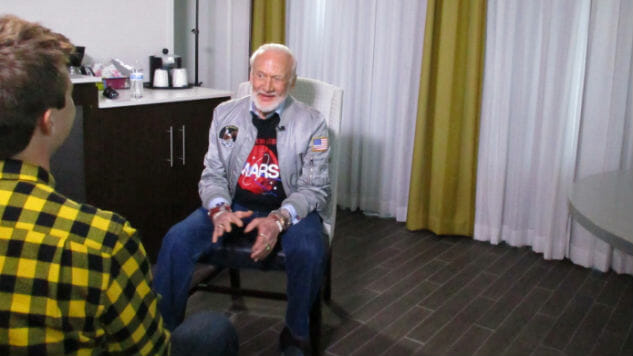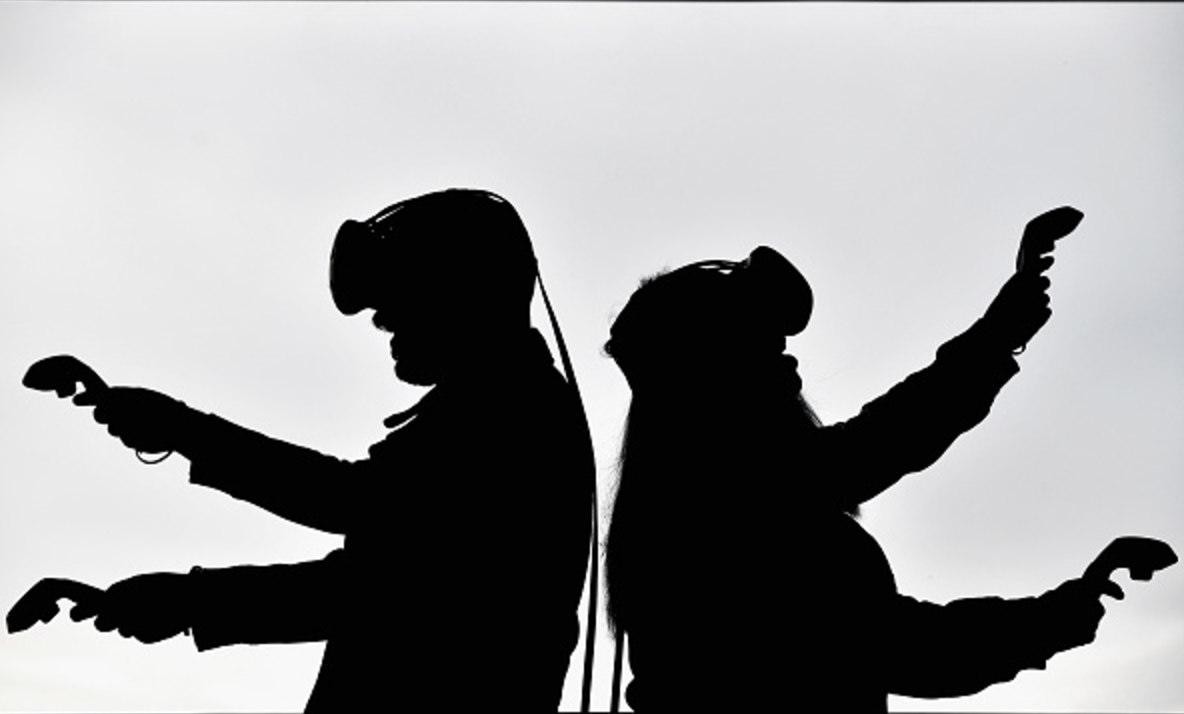
“I want to be known for more than kicking up moon dust.”
His passion speaks for itself when, at the age of 87, he’s come to SXSW to discuss his dream of Mars occupation.
He walks in quietly, wearing a flight jacket over his signature “get your ass to Mars” T-shirt. His face is strangely familiar, his eyes are piercing—just like the hologram version of himself I’d met earlier.
“I’m a self-appointed ambassador, I am not looking for votes,” he says, in explanation of his mission. “I’m looking for support,
His plan? He calls it the “cycling pathways” and he’s here to share his plan for getting humans to Mars. A company called 8i is helping to make it happen—at least, the first small steps.
Together, Aldrin and 8i have made a virtual reality experience called “Buzz Aldrin: Cycling Pathways to Mars.” Amy Sezak, 8i head of Communications, explains that their goal is to enable AR and VR content by creating what she calls “fully volumetric holograms” of humans.
“In order for VR to become mainstream and deliver on its potential is we need to enable human content,” she says. “Because the number one thing that we watch is people.”
Their vision began when Eugene d’Eon decided to make the leap from CGI to video based characters. He’d previously worked at Weta, with Peter Jackson on the Lord of the Rings, and found himself inspired by the potential to convey human forms with realism.
He started working with Linc Gasking, the future co-founder of 8i, who had similar aspirations. Gasking had tried a VR experience and, according to Sezak, described it as “a lonely experience.”
“You get to go to all these places but you’re by yourself, how cool would it be if you had a human there to take you on this journey.”
It was this inspired idea that ultimately led to their collaboration with Buzz Aldrin and their virtual reality experience. Who better to accompany viewer to the “magnificent desolation” than the man who coined the term?

Photo by Jeff J Mitchell / Getty Images.
The hardware used is HTC Vive, a room-scale virtual reality headset. The key that differentiates this VR experience is what Sezak describes as “volumetric medium.” This means that you can actually move around in the experience.
“You move and the Vive moves with you, so you’re equilibrium isn’t thrown off,” she says. “This is key for creating the level of immersion for which they are striving.”
The experience is incredibly engaging. The viewer enters a very plain room that looks the inside of a movie space ship. Cinematic music plays—French horn, dramatic strings, all the classic epic movie choices. The scene becomes the vastness of space. Holographic Buzz Aldrin appears. He is friendly—eyes agleam with untethered enthusiasm for this mission to Mars.
Aldrin begins to explain his plan of “cycling pathways to Mars.” In essence, the plan revolves around the concept of a “cycler” spacecraft that would travel between Earth and Mars,” as his website describes. Eventually this would result in a settlement that is perpetually populated by a rotating crew that could achieve the goal that Aldrin describes as occupying Mars.
The experience goes into detail. Aldrin’s hologram makes grand hand gestures that are accompanied by volumetric holograms of the ships, moons, and planets involved. It all makes a great deal more sense when it’s laid out in such a spatial form. The planets hover, in reaching distance, but they are only holograms. They seem real. The visions seems clear and possible—presented in this fully immersive space. A dream is brought to life.

Photo by Timothy Hiatt / Stringer / Getty Images.
The hologram of Aldrin represents him well. After experiencing the VR experience, the man seems oddly familiar. His eyes are bright, a stark blue illumined by the large windows in this hotel room and his depth of passion for his Mars vision. As he becomes more immersed in details of the plan, his hand gestures become grander and more expansive. One can almost picture the ships and planets of VR experience as he gestures and speaks of them.
He begins to discuss his plan for Mars occupation in detail, explaining that “if you set your mind at wanting to do something, you see what the steps are. If you try and do everything at once it makes it very complex, you’re demanding fidelity in everything you don’t need to. When I saw the word pathways, I thought that described it very well.”
These pathways allow it all to be broken down into smaller, reasonable, goals that can be achieved and tested.
“Understand the conditions under which we are going to use something. Design something and we can see how it works on the ground. Then we can put it in orbit. Then we can take it to the moon and back and put it on that cycle and we can intercept it between the earth and the moon and see how that works.”
This would prove that we have the capacity to make such interception in space.
The interceptions are just one step in the process of the Mars mission. Many other factors will come into play. Eventually Aldrin describes his goal as to ” bring things together to make a habitable place for a number of people.”
Aldrin displays a candid and pragmatic perspective as he outlines his experience. Money is always a limiting factor and Aldrin proposes that the U.S. might design some of the structures, then share those designs with Europe, Russia, Japan, and China. In his opinion the US might make an offer along the lines of “You land ‘em and we’ll put ‘em together and we’ll see whether it works.”
“A beautiful game,” as he describes it.
That sense of teamwork is heavily present in many of Aldrin’s opinions. When asked about his support for political administrations, he deftly responds that “I’m not a commentator, I’m not involved in politics. Whoever is in the Whitehouse has to be my friend. Because I want to work with whoever it is.”
His goals are long term and he knows it.
“I’m also very mindful of an individual who sets a course, sets a priority an objective as a national or a world leader to do something that isn’t gonna happen until he has, or she has, or she has retired and doing something else.” This is a goal he has fully embraced by participating in the creation of “legacy” VR. It is something he wants future generations to be able to look back on.
After a particularly detailed tangent, Aldrin pauses and takes notice of one of the interviewers.
“You’re nodding your head, I hope you understand it. And I hope I’m able to communicate that to people. Because that will make a big difference.”
That’s what he came here for: to share his dream. The “Cycling Pathways to Mars” VR experience brings that dream to a volumetric, holographic, reality.
Real life Aldrin approves the message.